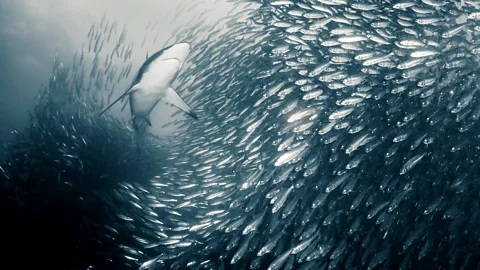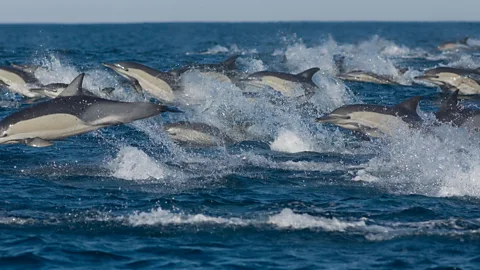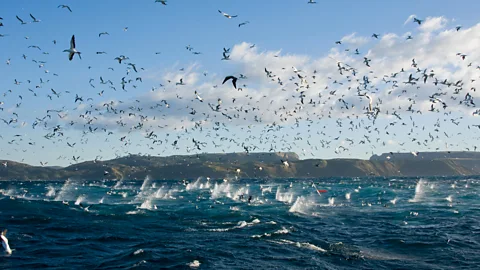 Alamy
Alamy
A bronze whaler shark feeds on sardines during the annual sardine run off the east coast of South Africa (Credit: Alamy)
South Africa’s sardine run is a spectacle to behold as thousands of predators feast on sardine mega-shoals – but climate change and over fishing are putting it at risk.
“There might be a few gannets here and there, but nothing major,” says Stephanie Plön, a marine biologist at Stellenbosch University, South Africa, who studies the health of marine mammals off the KwaZulu-Natal coast. “Then all of a sudden they come together – and you see the water boiling, as dolphins and sharks follow the sardines, and the gannets start diving. You have to give up taking [identification] photos, because there are just too many dolphins!”
ON THE MOVE
Every year, ocean species travel across the globe on their annual migrations. Follow their movements with stories from BBC Future – be sure to check back and join us as we explore the underwater highways of the deep.
 Alamy
Alamy
Common dolphins form super-pods of thousands of animals during the sardine run (Credit: Alamy)
As these cool-water Atlantic Ocean sardines move northwards, the shoals are penned in, trapped between the eastern coastline of South Africa and the warm waters of the southward-flowing Agulhas Current. As the shoal moves north, it attracts thousands of predators.
“The sardines are trying to stay out of the Agulhas Current,” says Peter Teske, an expert in marine genomics at the University of Johannesburg, South Africa. “They don’t like this hot water – and move up the coastline in a relatively shallow area of cooler water. At Waterfall Bluff, in Lusikisiki Eastern Cape, the Agulhas Current is so close to the coast, they bottleneck.”
By its peak in June, the sardine run is a feeding frenzy. As many as 18,000 common and bottlenose dolphins round the sardines up into bait balls, stretching 20m (66ft) in diameter. Now, they are easy pickings for other predators too – and sharks, whales, seals and birds join in this most plenteous of ocean banquets. (Watch the BBC Earth video below to see predators’ tactics during a sardine run feeding frenzy – and the defensive behaviours of the sardines).
“The sardine run is an exceptional event and an important part of the food web,” says Teske. During an upwelling event, he says – when cold, nutrient-rich water comes to the surface – phytoplankton blooms, zooplankton feeds on the phytoplankton, fish feed on the zooplankton, “and essentially everything else” feeds on the fish. “Suddenly, there is this huge source of protein.”
For the few sardines that survive the onslaught, the future remains bleak. The shoal continues north, moving with the cold water – until the upwelling ends. “They just keep moving into warmer water – the worst possible habitat,” says Teske.
These cold-water sardines find themselves trapped in a subtropical habitat, too hot for them to survive. The epic thousand-kilometre journey of this little fish ends in an “ecological trap” – making the sardine run a rare example of a mass migration that has no apparent benefits for the survival of the species.
“We don’t know the ultimate fate of the majority of them,” says Teske. “But, once the run is complete, it’s very likely a lot of them do die.”
But one thing is certain, an entire food web – including endangered species such as the African penguin, Cape cormorant, Cape gannet, and school shark – relies on the sardines to make the run. Now, over-fishing and warming oceans are causing sardine stocks to collapse and the world-famous sardine run could be at risk of ending within a few decades.
 Alamy
Alamy
Cape Gannets plunge-diving on sardines (Credit: Alamy)
Oceans have no borders, and the sardine run attracts animals from across the world.
Plön says: “Since 2000, oceanographers have been noticing a change in the sardine run. Previously, it was big, with lots of animals, and very temporally defined. Now, it’s more like little pulses going through, that might last five to 10 minutes. And the timing of the run is not as predictable anymore.”
Changes in phenological events like this – recurrent natural events such as bird migrations or the flowering of plants – can act as a bioindicator of climate change, says Plön.
Plön, who works in Stellenbosch University’s department of pathology, studies the health of cetaceans by looking at the contents of their stomachs. “There were about a hundred stomachs in the freezer when I arrived at Port Elizabeth Museum [in South Africa],” she says. The stomachs – defrosted and examined by Plön’s PhD student, Shannon Ambrose – belonged to common dolphins which had been accidentally caught in shark nets along the KwaZulu-Natal coastline between 2000 and 2009. “The common dolphin is the species known for the sardine run. It’s the species that forms super-pods of thousands of animals,” says Plön. “You have to open them up and look at the fish and squid that’s in there, at various stages of digestion.”
The ear bones of the fish, or otoliths, says Plön, remain intact after digestion, as do the mouth parts of squid. “The cool thing is they’re species specific,” she says. “So, I can tell a mackerel from a sardine. You can also measure them and calculate the size of the animal that was eaten. So, it gives you a lot of information about the last meal.”
“It’s like we’re just documenting extinction” – Stephanie Plön
The team compared their findings with data collected between 1972 and 1992, and discovered a huge shift in the dolphins’ diet. “The animals had previously fed mainly on sardine – it’s the sardine run, that’s what you expect,” says Plön. “But they weren’t feeding on sardines anymore. They were feeding on mackerel,” she says.
The study, says Plön, illustrates how we can trace changes in the Earth’s patterns by looking at “sentinel” species – or harbingers of danger. Like canaries in a mine used to warn of toxic gases, “cetaceans are indicators of ocean health”, she says. However, she adds, as over a third of all cetacean populations are of conservation concern, this concept is “problematic”. “We have increasing numbers of species disappearing – you can’t really call them sentinels anymore if the sentinels are gone,” she says.
 Alamy
Alamy
Trawl fishermen in South Africa’s port city of Durban haul their sardine catch on to the beach (Credit: Alamy)
“When events like this are disrupted it can have a knock-on effect,” warns Plön. Phenological shifts can disrupt entire ecosystems following relatively small climatic changes. But experts say there are few studies exploring shifts in the timing of migratory fish species like sardines – and more research is needed if we are to understand the interplay of warming atmospheric and oceanic temperatures, and what we can do to mitigate its impacts.
So, other than stopping climate change in its tracks, is there anything we can do to prevent the sardine run disappearing for good? Sardines are an important commercial fish species in South Africa. Following rapid declines in the landings of sardines during the mid-1960s, the industry changed its fishing strategy to use smaller-meshed nets to target juvenile anchovy. Anchovy dominated the catches for the next 25 years, allowing sardine populations to recover.
But Plön is not encouraged. “I have a lot of colleagues who have environmental anxiety,” she says. “We have more and more endangered marine mammals around the globe, marine heat waves, more and more unusual mortality events. It’s just increasing. And we can see it. We’re reaching a point where it’s happening very fast, with so many different factors – it’s almost like we’re just documenting extinction,” she says.
Source link : https://www.bbc.com/future/article/20240520-how-south-africas-sardine-run-is-changing
Author :
Publish date : 2024-06-08 05:45:10
Copyright for syndicated content belongs to the linked Source.





